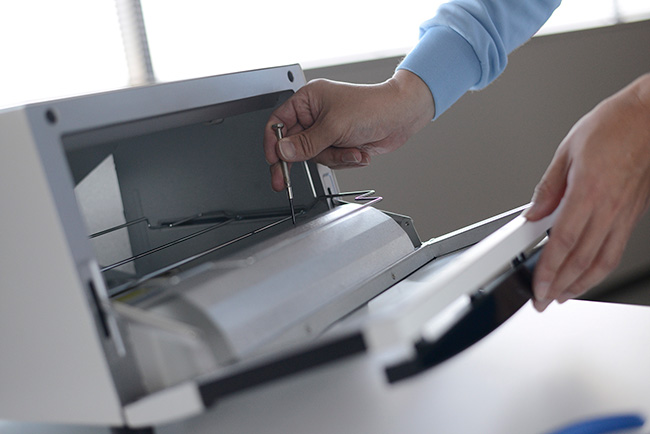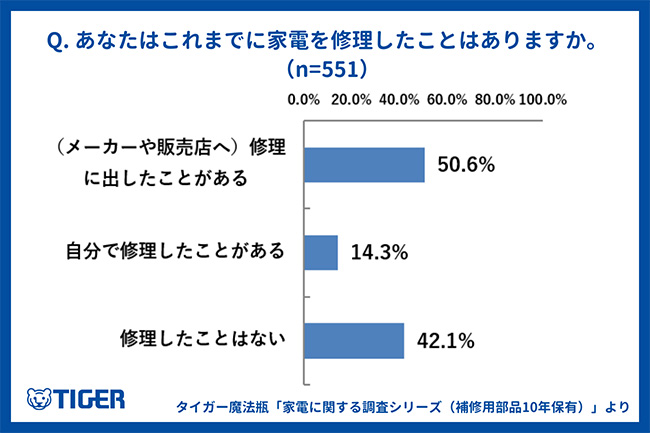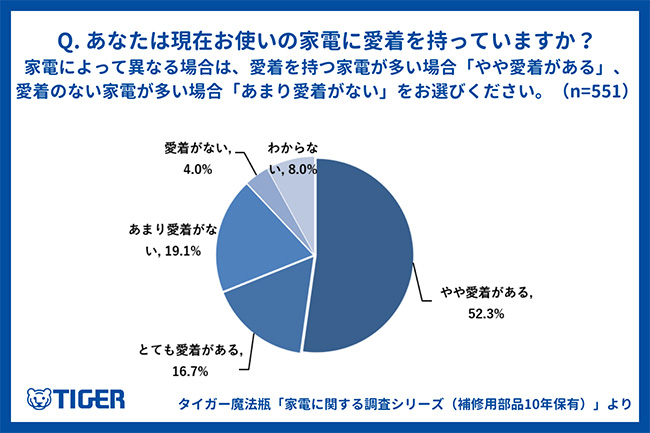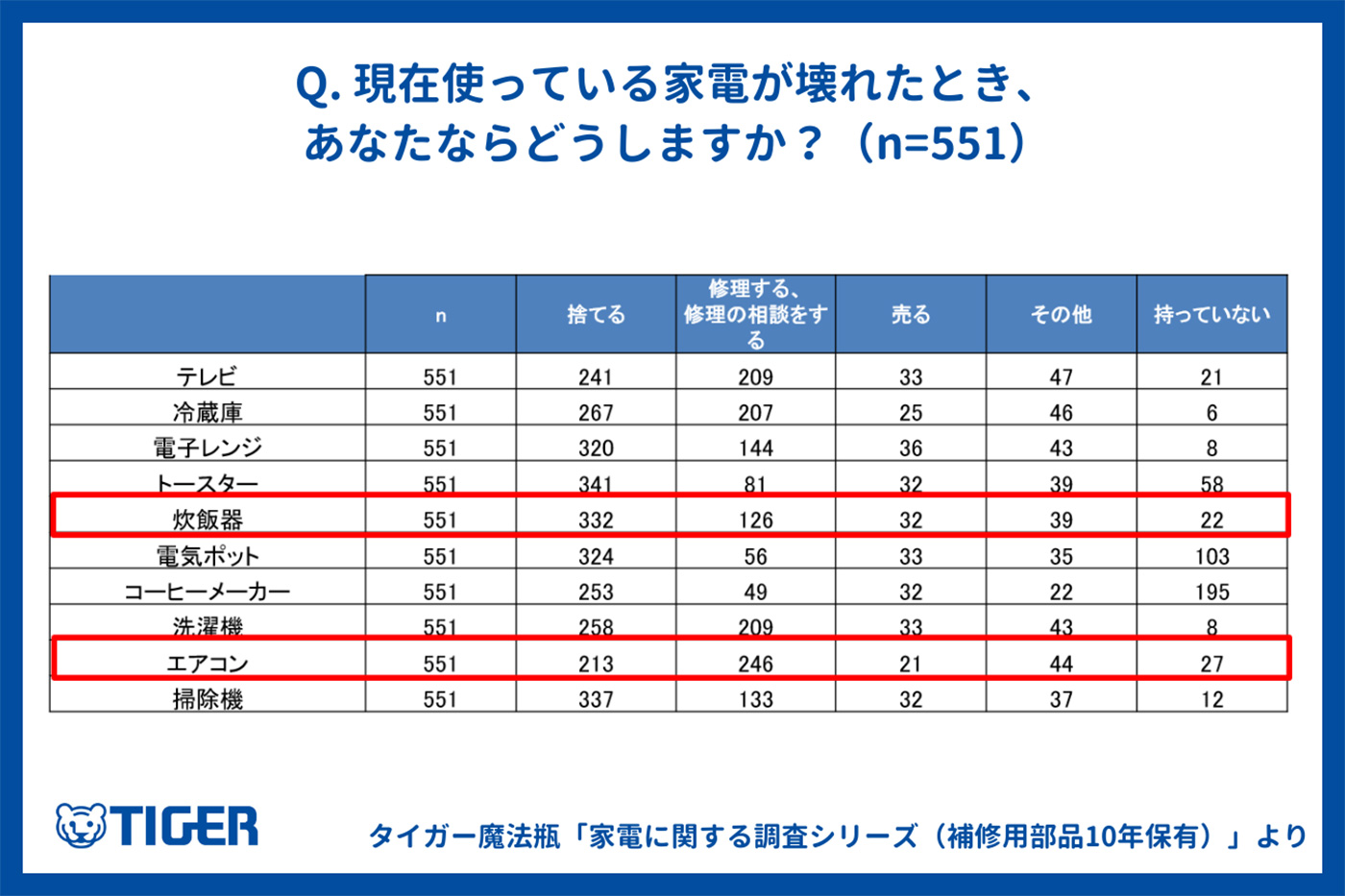Survey Series on Tiger Corporation and Home Appliances (10-year hold on repair parts) vol.4
About half of the respondents have never sent their appliances for repair!
Among them, 3 out of 5 “throw away rice cookers without repair when they break down!”
Survey Series on Tiger Corporation and Home Appliances (10-year hold on repair parts) vol.4
Tiger Corporation is committed to providing you with long-lasting service for your beloved home appliances.
Tiger has been committed to providing 10 years*1 of repair parts, which is longer than the industry standard.
Tiger Corporation (President: Yoshisato Kikuchi, Headquarters: Kadoma, Osaka), a world leader in thermal control technology with a 10-year warranty*1 on spare parts, has announced the results of a survey of 551 men and women in their 20s to 60s conducted as part of a series of surveys on home appliances.
In this fourth edition of the survey, we present the results of a survey on attitudes toward home appliance repair. In order to realize a sustainable world, it is important to start small and steadily engage in environmentally friendly activities that we can do ourselves. As efforts to repair and use good products for a long time are gaining momentum around the world, there is a movement among home appliance manufacturers to establish a repair system to prolong the life of a single product.
We are also committed to providing after-sales service that allows our customers to use their beloved home appliances for a long time.
*1 Some repair parts may not be retained for 10 years because they may not be supplied after less than 10 years depending on material procurement, facility conditions, or other factors. Faor other detailed conditions of 10-year retention, please refer to the following detailed pages.
Details https://www.tiger-corporation.com/ja/jpn/about-us/after-service/

vol.4 Survey Summary
- About half of the respondents have never sent their appliances for repair (to the manufacturer or dealer).
- While about 70% were found to be attached to the appliances they currently use. For many appliances, the option of “throw away” rather than “repair” is the most likely to be taken when they break down. Among them, when a rice cooker breaks, about three out of five respondents throw it away instead of repairing it.
Comments from Tiger Corporation
We started this service in the hope that our customers will be able to use their beloved products for a long time. Repairing a product using repair parts can be cheaper than replacing it, and if only one part can be replaced, fewer products will be thrown away, which is environmentally friendly and will lead to the realization of a sustainable society. We will continue to do our utmost to improve the quality of our products so that they can be used as long as possible without malfunctioning, but we would like you to know that there is also the option of “repair” in the event of a malfunction.
Even if there is no malfunction, for example, we can replace the peeled or worn gaskets on the inner pot and lid of a rice cooker, so please check the retention period of performance parts for repair at the time of purchase.
[Survey Overview]
Survey target: A total of 551 men and women in their 20s to 60s from all over Japan
Survey method: Internet research using “Fastask” by JustSystems Inc.
Survey period: Monday, February 26, 2024 to Wednesday, February 28, 2024
*The results are rounded to the nearest whole number, so there may be an error in the results if the results are calculated on a stacked basis.
*When presenting the results of the survey, please include the following note: “From Tiger Corporation and Home Appliance Survey Series (10-year ownership of spare parts)” and the following text: “Tiger Corporation and Home Appliance Survey Series (10-year ownership of spare parts)”. URL (https://www.tiger-corporation.com/ja/jpn/about-us/after-service/) of the 10-year ownership of repair parts page.
About half have never sent an appliance for repair (to a manufacturer or dealer).

In the previous survey, more than 80% of respondents answered “because it broke” as the reason for replacing home appliances. 3
In this context, when asked if they had ever had their appliances repaired, 50.6% had sent them to a manufacturer or retailer for repair, while about half had never sent them to a repair store. Even when those who have done repairs themselves are excluded, about 40% have no experience with repairs, suggesting that many people still do not make repairs an option when their appliances break down.
*3 Survey series on Tiger Corporation and home appliances (10-year ownership of repair parts) VOL.3
https://www.tiger-corporation.com/ja/jpn/newsroom/press-release/pr_240529_01/
About 70% of respondents are attached to their current appliances.

Regarding the appliances they currently use, 52.3% of respondents answered that they are “somewhat attached” to them, and 16.7% answered that they are “very attached” to them. In a previous survey*3, 90% of respondents said they want to use their appliances as long as possible unless they break down, indicating that the majority of people want to use what they like for a long time.
*3 Survey series on Tiger Corporation and home appliances (10-year ownership of repair parts) VOL.3
https://www.tiger-corporation.com/ja/jpn/newsroom/press-release/pr_240529_01/
For many appliances, the “throw away” rather than “repair” option is most likely to be taken when they break.
Among these, when a rice cooker breaks, about three out of five people throw it away instead of repairing it.

The respondents were asked what they would do if their current appliances broke down (n=551) for each of the 10 types of appliances. Of these, three out of five respondents would “throw away” their rice cookers. On the other hand, more respondents answered “repair or consult with a repair shop” for air conditioners (44.6%) than those who chose to throw them away, indicating that the response to a broken appliance varies depending on the appliance. However, with the exception of air conditioners, a high percentage of respondents discarded them immediately without repairing them, suggesting that appliances that can still be used may be discarded. Despite the fact that the answers to the previous question revealed that as many as 70% of the respondents were attached to their current appliances, the situation suggests that appliance repair is not widespread.
We learn the option of repairing appliances instead of discarding them immediately, so that we have a choice other than to discard our beloved appliances when they fail. On the other hand, if the manufacturer does not have the necessary parts to repair the appliance, it cannot be repaired in the first place. Parts necessary to maintain the functionality of an appliance are called “repair performance parts,” and manufacturers hold on to these parts for a certain period of time in case a product fails and needs to be repaired. The period of time that manufacturers must hold on to performance parts for repair is specified in the manufacturer’s labeling rules (e.g., six years after discontinuation of production in the case of rice cookers), but Tiger Corporation has set the holding period for all products at 10 years*1 in order to ensure the long use of your beloved home appliances.
*1 Some repair parts may not be retained for 10 years because they may not be supplied after less than 10 years depending on material procurement, facility conditions, or other factors. For other detailed conditions of 10-year retention, please refer to the detail page. Details https://www.tiger-corporation.com/ja/jpn/about-us/after-service/
Interviews with employees about their thoughts on after-sales service are available on the official website.
Part1: Tiger’s commitment to after-sales service
What we can do to make your Tiger products last longer
https://tiger-corporation.com/ja/jpn/feature/blog/magazine/parts10years-1/
Part 2: Getting Appliances Checked Before They Break? What is Refresh Maintenance?
Professionals from Tiger’s repair jurisdiction department introduce tips on how to take care of your appliances for long-lasting use!
https://tiger-corporation.com/ja/jpn/feature/blog/magazine/parts10years-2/
Part3: Aiming for Sustainable After-Sales Service.
Tiger Kamado” was born from a single employee in the department in charge of “10-year retention of spare parts.
https://www.tiger-corporation.com/ja/jpn/feature/blog/magazine/parts10years-3/